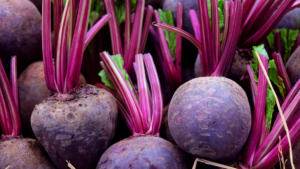“I love beets. Show me a salad bar and I will clean them out of their beets.” — Chris Pratt
Beets are an excellent crop to get your garden started with in early spring. They can be planted when soil temperature reaches 50 degrees and will mature in 55 to 60 days. In fact, the beet greens may be ready to harvest in only 2 to 3 weeks.
Beets are one of the most versatile crops as there is a wide variety of ways to prepare both the greens and the edible root.


FAST FACTS
Benefits and nutritional information:
- Beets have an impressive nutritional profile, containing various amounts of almost all of the vitamins and minerals your body needs.
Starting:
- Beets are generally started from seeds planted directly into the garden. It is possible to start them indoors, but they are difficult to transplant with success.
- Sow seeds 1/2” deep, 1” to 2” apart in rows that are about 1 foot apart.
When to plant:
- Beets can be planted from early spring — as soon as soil temperature reaches 50 degrees — through early fall, although they don’t do well when daytime temperatures exceed 75 degrees in mid-summer.
Thinning, training
- Thinning should begin when the sprouts begin to get crowded in the row. Plants left to mature should be 5”s to 6” apart.
- The young tops that are removed during thinning make excellent greens for the table.
Signs of over-watering, nutrient deficiency
- Leaves that turn yellow may be a sign of nitrogen deficiency. Others that are stunted could be deficient in phosphorus. Other leaf problems in beets may be due to deficiencies in micronutrients such as boron, magnesium, copper, etc. Mixing a well-balanced fertilizer into the soil is the best approach to resolving these symptoms.
- Sprinkling coffee grounds on the soil lowers the pH, which can be beneficial for beets. They can also discourage crawling insects like slugs.
Pests and pest controls
- Avoid planting beets where swiss chard or spinach has recently been grown since they are in the same family and are therefore susceptible to similar pests and diseases.
- Beets can be threatened by a variety of insect pests, but the most common are cutworms, leaf miners and flea beetles.
Harvesting
- Beet greens may be harvested early, while the plant is still developing. Picking just one or two greens will leave enough leaves to allow the plant to still pump energy into the root.
- As the beet roots start to bulb, they push out of the ground. When they’ve formed a nice, round bulb about 2” in diameter (depending on the description in the seed catalogue) they are ready to harvest.
- Allowing beets to stay in the ground past their optimal stage results in a tough, less sweet root that may sometimes split open.


